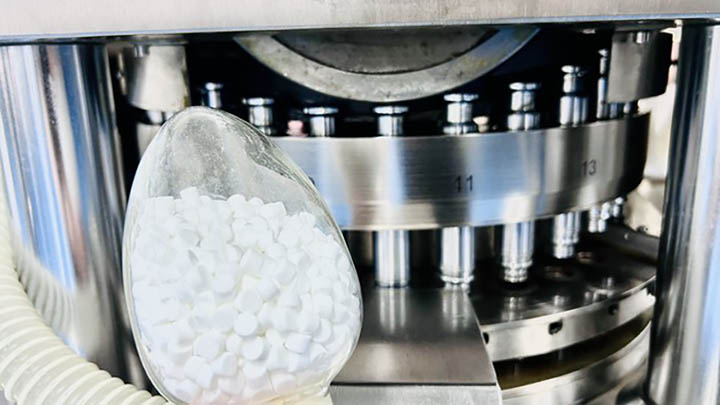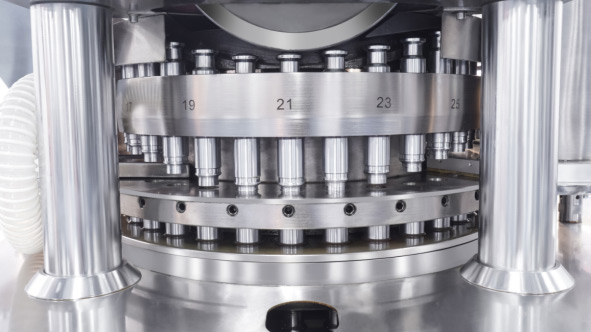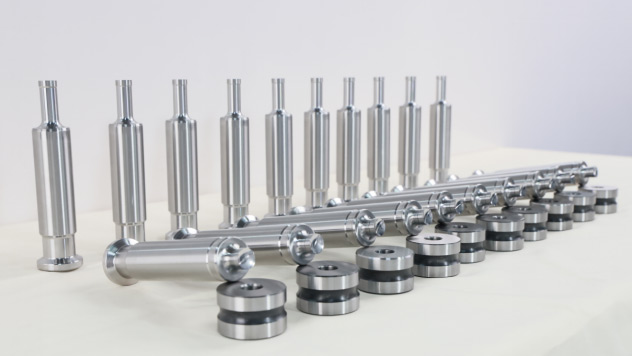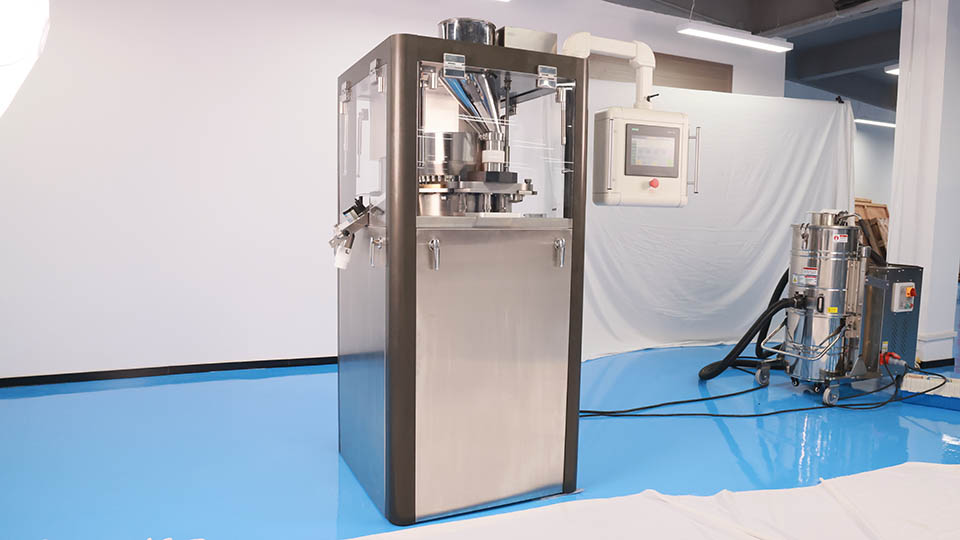Lors du choix d'une presse à comprimés, quels sont les pièges que certains acheteurs sont susceptibles de rencontrer ? Quels sont les points importants que les acheteurs peuvent négliger avant d'acheter une presse à comprimés ? Cet article analyse ces aspects et décrit en même temps les types et la théorie de fonctionnement des presses à comprimés.
UN presse à comprimés machine à écrire est un système mécanique conçu pour compacter des substances en poudre en pilules uniformes, une fonction essentielle à la fabrication pharmaceutique. Presse à comprimés Les machines sont essentielles pour garantir une cohérence de dosage précise dans produire comprimé de médicament sable diététique suppléments.

comprimés de médicaments et une presse à comprimés pharmaceutique
Pilule presse machines exister en plusieurs types adaptés aux exigences spécifiques de production. Identifier les différentes catégories de presse à comprimés les machines sont essentielles pour choisir approprié équipements pour vos opérations de fabrication.
· Célibataire- Punch Machine de fabrication de pilules : UN aussi appelé comme un coup de poing unique comprimé presse, est idéal pour une production limitée et applications de laboratoire nécessitant des quantités minimales de comprimés. Ceci pilule presse machine fonctionnalité res une seule combinaison de poinçon et de matrice , inadapté à la production pharmaceutique de masse.
· Presse à comprimés rotative : Conçu pour la fabrication pharmaceutique à grande échelle, un r otaire t able machine produit es des milliers de comprimés par heure par toi tiliz ant un tour tournante ntable équipé de nombreux poinçons et matrices.
· Presse à comprimés automatique euh: Un un automatique pilule la machine à presser est également une presse à comprimés rotative et plus encore améliore l'efficacité. Un entièrement presse à comprimés pharmaceutique automatique permet une surveillance et un paramétrage en temps réel réglage, garantissant une qualité constante avec un minimum manuel participation .

le mécanisme principal d'une presse à comprimés automatique
· Presse à comprimés hydraulique : UN h hydraulique comprimé presse euh formulaire s comprimés en appliquant une pression liquide , idéal pour les matériaux nécessitant une plus grande force de compactage. Une presse à comprimés hydraulique servir s secteurs allant des applications médicales aux applications industrielles, notamment pour les relations publiques essing comprimés avec des exigences précises de dureté ou de densité , bien que plus lent que un rotatif machine à comprimés .
· Multi-stations Pilule Presse : UN comprimé avec presse machine à ions avec multi-stations produire simultanément s comprimés en mu petit tailles et formes. Cette capacité élimine es le besoin de plusieurs machines , essentiel pour la production à grande échelle en raison de et capacité de fabrication plusieurs types de comprimés simultanément.
Une presse à pilules machine repose sur plusieurs éléments essentiels travaillant ensemble pendant comprimé pressage :
|
Composants |
Fonctions |
|
Coups supérieurs |
Compressez la poudre ou les granulés dans les cavités centrales pour former des comprimés. |
|
Coups de poing inférieurs |
Soutenez le lit d'ingrédients (poudre/granule) et la force de compression des poinçons supérieurs, puis éjectez enfin les comprimés finis. |
|
Meurt |
Définir les formes et les tailles finales des comprimés, en garantissant l'uniformité du produit. |
|
Trémie de chargement |
Charge la poudre ou les granulés dans la chambre de pressage des pilules. |
|
Rouleaux de compression |
Inclut des rouleaux supérieurs et inférieurs pour fournir la force de pression nécessaire pour compacter la poudre en comprimés solides. |
|
Cames |
Éléments clés du tra n Système de transmission qui guide les cycles de mouvement des poinçons pour une formation de comprimés uniforme. |
|
Distributeur d'ingrédients |
Transfère en continu de la poudre ou des granulés vers les cavités de la matrice, essentiel pour la fabrication de comprimés à grande vitesse. |
|
Mécanisme d'éjection |
Retire les comprimés finis des cavités de la matrice pour les étapes de traitement ultérieures telles que l'enrobage des pilules ou l'emballage sous blister. |

poinçons inférieurs, poinçons supérieurs et matrices (de gauche à droite)
Au-delà des composants fondamentaux au-dessus de , presses à comprimés à la pointe de l'industrie intègrent des fonctionnalités avancées spécifiquement conçues pour améliorer la qualité des tablettes, l'efficacité opérationnelle et la conformité réglementaire. Des entreprises comme Romaco et Emballage riche illustrent cet engagement, en concevant et en fabriquant machinerie qui répondent aux normes strictes cGMP et CE, établissant ainsi des références dans le secteur des équipements pharmaceutiques.
Un bon exemple est RQ de Rich Packing HGZP 26/40D grande vitesse comprimé machine presse. Ceci presse-pilules intègre moderne composants:
· Intelligent Système de lubrification : UN automate iquement fournit une lubrification précise et programmée aux pièces mobiles critiques, éliminant ainsi les risques de sous-lubrification ou de sur-lubrification.
· Intelligent IHM (Interface Homme-Machine) : UN permet aux opérateurs d'affiner les paramètres tels que le poids et l'épaisseur des comprimés avec une précision numérique , offre ant gestion des recettes, surveillance en temps réel, dépannage simplifié, etc. .
· Système d'extraction de poussière double :Utilisant deux points d'aspiration stratégiquement placés , il élimine les particules en suspension dans l'air générées lors de la compression dans le cadre des efforts visant à prévenir t contamination croisée.

le RQ HGZP 26/40D presse à comprimés à grande vitesse
T ces avancés composant s sur un presse machine à comprimés aimer Les RQ HGZP 26/40D démontrent comment la technologie de pointe ies se traduisent directement par une consistance supérieure des comprimés, une réduction des déchets, et sécurité renforcée de l'opérateur .
Choisir une machine à presser les comprimés basé uniquement sur le coût initial sans analyse dehors L'absence de fonctionnalités de soutien à la qualité entraîne des inefficacités opérationnelles coûteuses et des problèmes de qualité. Comprendre les pièges avant d'acquérir une presse à comprimés est essentiel pour une efficacité, qualité production.
L’une des erreurs critiques que commettent les acheteurs est de sous-estimer leur volume de production. exigences et opter pour une vitesse moyenne machine à presser les pilules Cela devient un problème lorsque la sortie cible atteint s 150 000+ pharmaceutique comprimés par heure – un débit où la vitesse moyenne une machine à pilules typiquement automne s court, causant un goulot d'étranglement de production.
Le tableau ci-dessous montre les relations entre le rendement de production cible et nos recommandations de machines et de modèles.
|
Sortie cible |
Sélection de la machine |
Modèle recommandé |
|
30 000 à 60 000 comprimés/heure |
vitesse moyenne |
RQ-ZP-27D |
|
60 000 à 90 000 comprimés/heure |
vitesse moyenne |
RQ-ZP-29D |
|
90 000 à 150 000 comprimés/heure |
vitesse moyenne |
RQ-ZP-25/55D |
|
150 000 à 260 000 comprimés/heure |
grande vitesse |
RQ-HGZP-26/40D |
|
300 000 à 680 000 comprimés/heure |
grande vitesse |
RQ-HGZP-45/75D |
En outre, un vitesse moyenne pilule comprimé presse est plus susceptibles de générer des comprimés avec des taches noires en surface. Ceci peut se produisent en raison d'une dissipation thermique inadéquate résultant en carbonisation du lubrifiant, potentiel accru de frottement métal sur métal générant des particules fines, ou extraction de poussière moins efficace par rapport à un grande vitesse compresseur de pilules De tels défauts sont inacceptables pour des comprimés pharmaceutiques de haute qualité.
· Quantifier votre n les besoins : Calculez rigoureusement vos besoins horaires de production de pointe et soutenue, y compris les projections de croissance future. Assurez-vous la capacité de production de votre comprimé presse es dépasse cet objectif.
· Scruter p article et h manger c contrôle : Évaluer un presse euh Caractéristiques de conception pour une élimination efficace de la poussière et une gestion de la chaleur afin de minimiser les causes de points noirs sur les comprimés de médicaments . Recherchez les dessins ferm